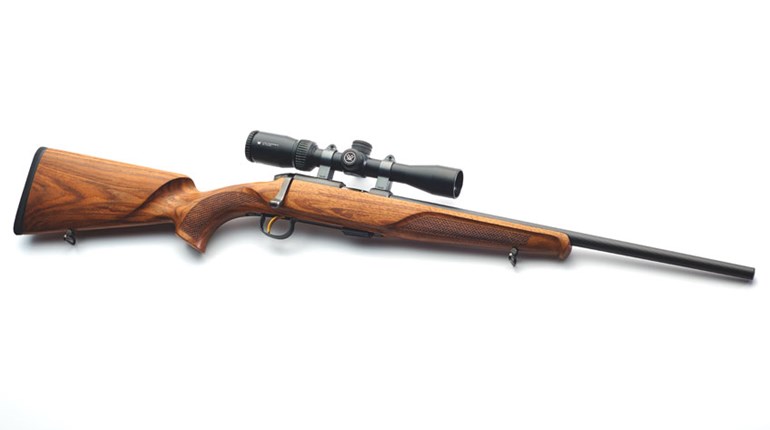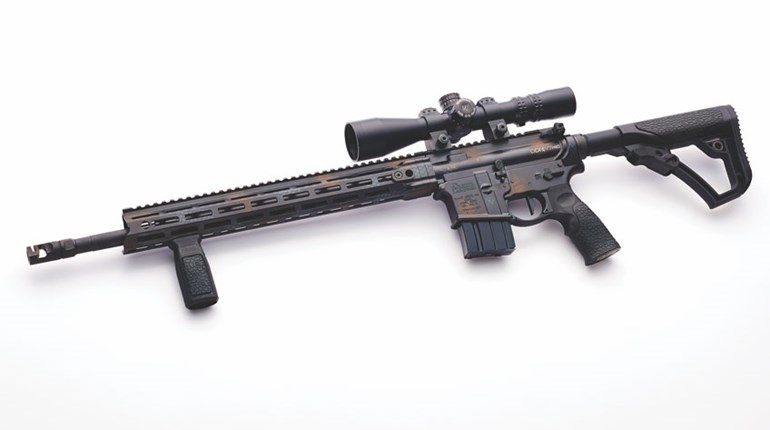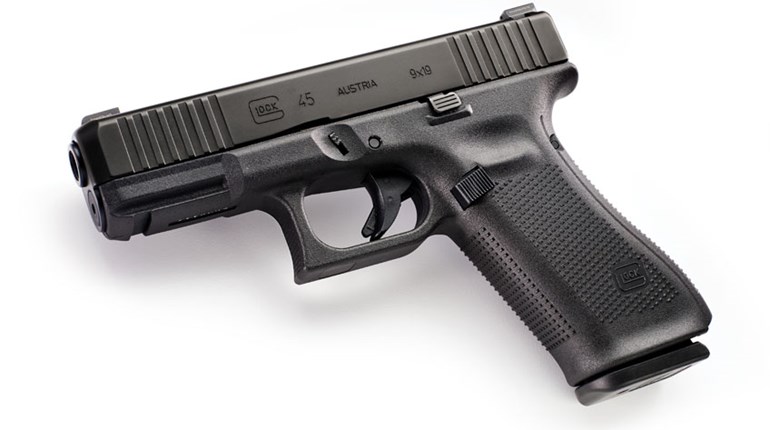
We feel obliged to begin with a caveat: We don’t regularly enthuse over lightweight firearms. With rare exceptions, the rationale of our objections is as self-evident as it is defensible—lightening, especially for the sake of “totability” alone, rarely passes a strenuous test in most other regards. Felt recoil, continuing accuracy and good Ol’ fashioned oops-proof durability seem to take predictable and proximate beatings. Often accompanied by considerable billfold lightening, weight loss seems a routinely chancy proposition, and an all-but-guaranteed downgrade in truly versatile performance.
To our rueful irritation, 2A Armament of Boise, Idaho, seems determined to make us rethink this philosophy. The exact modern argot, we think, is “pffft!” If that weren’t bad enough, they’re bringing not one but two lightweights to bear.
The leisurely first assault on our prejudice takes the form of twin modern tastes rolled into one: a modern sporting rifle with all the versatilities that implies, combined with 6.5 mm Creedmoor caliber. No stranger to Exercise Your Freedom (a splendid bolt-based example graced our March ’18 issue), today’s 6.5s generally put long, slender bullets with astonishing ballistic coefficients into what are considered “short” actions by bolt gun standards, though “long” by MSR tradition. In the present case, this corresponds to AR-10 length as opposed to AR-15 when applied to the modern sporting plan of Stoner, Fremont and Sullivan.
This comparatively short length cuts weight from the upper/lower core and is furthered by considerable additional sculpting in 2A’s XLR-20. Some of the sculpting is obvious—the upper dispenses with the forward assist and is fluted elsewhere to maintain strength as it shaves metal. The lower uses reduced wall thicknesses or outright perforation (the trigger guard) except around controls or stress points like pin holes.
Lightweight titanium components substitute for heavier steel at the gas block and in the through-drilled takedown and pivot pins (a refreshing breeze to push out by the way). The biggest slice comes from the 2A-spec’d Faxon 5r, 1:8 twist, 20-inch, near-pencil profile barrel and aluminum barrel nut. Even the lugs on the Picatinnies of both the upper receiver and 2A’s 6061 extruded, T-marked, M-LOK handguard are relieved, while a Mission First Tactical, 8-position minimalist stock helps knock the pre-sight tally to 6.85 pounds.
A full 10-round magazine and Steiner optic (a grand T5XI 4-16 with T-series rings, see “Nuts And Bolts”) didn’t push the scale back over 10 pounds. Liveried with a Cerakote KUIU camouflage pattern, there’s little doubt where 2A sees the XLR-20—nearly anywhere a long, precise shot is called for.
We chose that singular verb “is” with deliberation. Make no mistake, the Xanthos produced one MOA or better results with both match and hunting-type bullets in weights from 120 to 143 grains, especially when even modest care was taken to keep barrel temperature sensible. This is not precisely sequitur with a current penchant for parameterizing rifle performance primarily with shot-after-shot-after-shot, bench-type work, where the rifle in question may get carried a few hundred feet and shot for such a score. If your “carry” is measured in miles, however, a very different set of criteria might wisely apply. Lighter carry and repeatable cold-bore, one-shot excellence will likely matter more than miniscule groups. It was in this sort of shooting that the Xanthos impressed us most: Get on the rifle, take the shot. To 400 meters at least, this was just plain easy.
Getting such a cold-bore shot right depends on the shooter as much as the rifle, even one as good as the Xanthos 6.5 mm Creedmoor. It also sets the stage for 2a’s second—and sneakier—attack on our light-rifle apprehensions.
The 2A MSR in .22 Long Rifle configuration uses many of the same expedients on the mass problem with a simply astonishing 3.7-pound result. The vastly lower operating pressures of rimfire allows aluminum—notably as a fluted barrel sleeve—to stand in for the thickness of considerably heavier steel, while titanium pins reprise their centerfire role. A patent-pending Ti/polymer bolt runs inside the upper (“slick side” here, too), with an MFY stock and 2a handguard completing the diet.
Experienced shooters will likely anticipate why our range work with the .22 AR proved so very satisfactory. True, the varied, uncomplicated and inexpensive pleasures of rimfire were certainly manifest: Speed drills on the plate rack; competition on a dueling tree; steadily shrinking one-ragged-hole groups; and rapid, adjustment-free swaps of sight technologies (back and forth between a C-More Railway and a Nikon 1-4x Black Force 1000) comprise only a sample.
Truer, and better still, was the unexpected satisfaction in having our light-rifle apprehensions so thoroughly dashed by our pair of 2A Armament samples. Plainly, shooting excellent light rifles beats shooting merely light rifles.
Truest of all is the knowledge that even not-so-serious rimfire practice remains a time-honored analog to a centerfire shot that might be serious indeed.
Nuts And Bolts
Ammo
It pays to select ammunition carefully with both the center-fire and rimfire 2A Armament rifles. It’d be a substantial injustice, however, to let this suggest either was what could be called “finicky.” The meticulous crafting of both simply means that choosing ammunition with care lets them perform at their (impressive) best.
The most obvious “for instance” appeared in the 6.5 mm Creedmoor, where premium ammunition from top makers did not produce superior results as a matter of reflex. In point of fact, our best performances came with the least expensive ammunition, Winchester’s “Deer Season XP” 125-grain, and inspection of spent cases gave no cause for alarm.
This latter condition was not a universal result: The XLR-20 put everything we fed it downrange with routine precision, but we soon began to inspect fired cases closely. Offerings from Browning (BXR 129-grain), Freedom Munitions (140-grain AB), Hornady (Precision Hunter 143-grain ELD-X), Nosler (AccuBond Long Range 129-grain) and Prime (130-grain HPBT) were worry-free performers, but a nearly equal number—in several cases, from the same manufacturers—were not.

We think a trend of sorts emerges here: Ammunition makers seem intent on wringing every last foot per second out of some 6.5 confections—hardly news, nor altogether wrong. There is even modest precedent for this approach yielding the best across-the-board results from rifle to rifle. But there’d be no sense in hamstringing a superb 2A of your own with poorly matched ammunition or subjecting it to unnecessary wear and tear. As we often recommend—and still routinely find—hand loading for a rifle of the XLR’s quality is likely to give disproportionate benefits in shooting comfort, net cost, accuracy and longevity.
The 2A .22 Long Rifle proved much the same. Specific recommendations are often groan-inducing (here, read “wallet-busting”) but such was happily not the default. We found several listed choices readily available, exceptionally reliable and very accurate. The apparent first choice—CCI Standard Velocity—worked just as promised, producing 10-shot groups at 50 yards that nosed steadily closer to 0.5 MOA as we learned the ALG trigger. (It’s a shame the breathtaking 2-pound, 2-stage CMC of the Creedmoor doesn’t also run the rimfire, but we expect cost issues drive this.) We were also skeptical/suspicious of running “dry” as instructed, but this proved to be the ticket; a zero-malfunctions run remains unbroken well north of 500 rounds.
Optics
One word ought to say most of what needs to be said: Steiner. In specific terms, we were fortunate enough to have a T5Xi 3-15x50 at our disposal, and any sort of disappointment never entered the process. A product of German engineering and glass mated by American assembly, the first focal plane, MOA version (new for 2018, but H59 and MRAD versions are also available) proved a nearly foolproof complement to the flat 6.5 trajectories of the 2A XLR.
Beyond typical Steiner excellence, one characteristic stood out. Much as we like first focal plane, many reticles in the type unhelpfully harvest field of view as higher magnification increases apparent reticle size. It’s true that this effect grows less distracting as time goes on (and many smart folks think it’s a small price to pay for simpler “dope” math), but we hardly noticed it in the Special Competition Reticle of the T5. The illuminated, etched glass result doesn’t fade to a hint at low light and magnification levels, yet simultaneously remains open and sharply precise at higher powers. We hope you’ll trust us, and rediscover our appreciation for both on the Xanthos-Lite XLR-20.

































